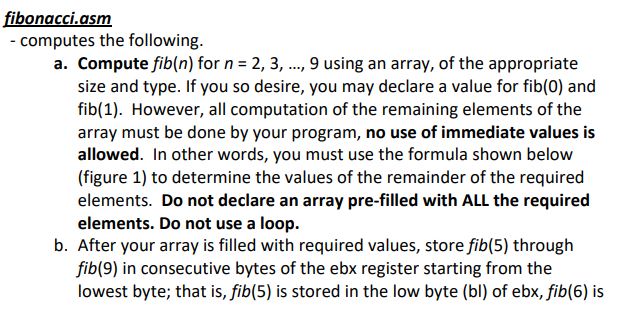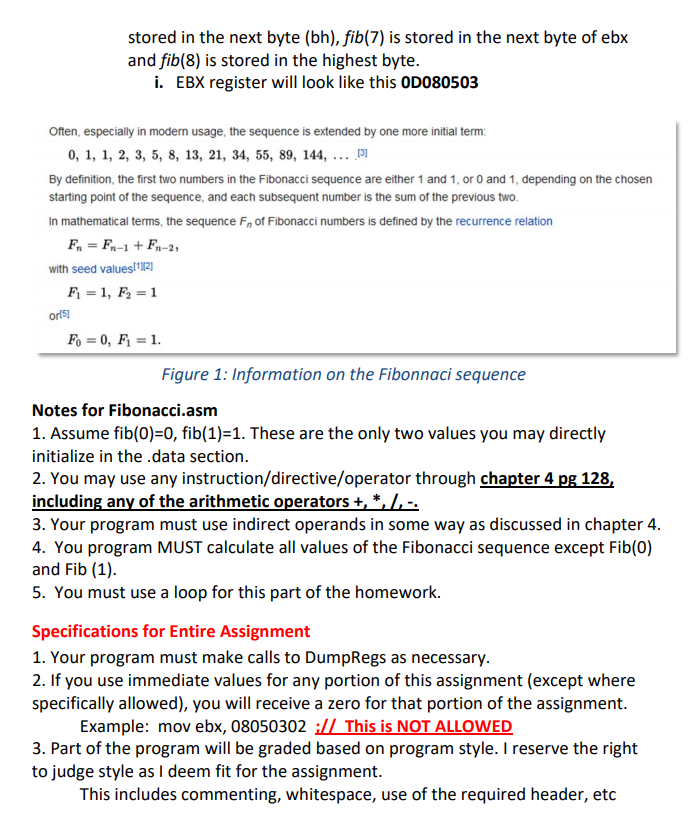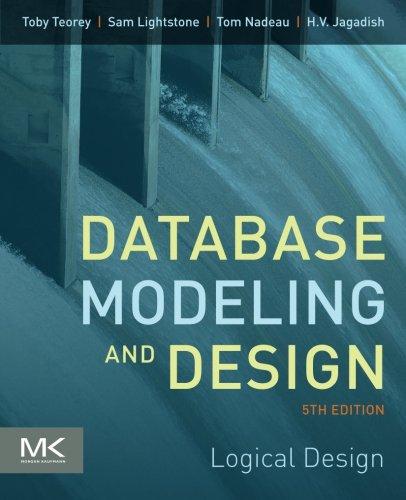

fibonacci.asm - computes the following. a. Compute fib(n) for n = 2, 3, ..., 9 using an array, of the appropriate size and type. If you so desire, you may declare a value for fib(0) and fib(1). However, all computation of the remaining elements of the array must be done by your program, no use of immediate values is allowed. In other words, you must use the formula shown below (figure 1) to determine the values of the remainder of the required elements. Do not declare an array pre-filled with ALL the required elements. Do not use a loop. b. After your array is filled with required values, store fib(5) through fib(9) in consecutive bytes of the ebx register starting from the lowest byte; that is, fib(5) is stored in the low byte (bl) of ebx, fib(6) is stored in the next byte (bh), fib(7) is stored in the next byte of ebx and fib(8) is stored in the highest byte. i. EBX register will look like this OD080503 Often, especially in modern usage, the sequence is extended by one more initial term: 0, 1, 1, 2, 3, 5, 8, 13, 21, 34, 55, 89, 144, ... 19 By definition, the first two numbers in the Fibonacci sequence are either 1 and 1, or 0 and 1, depending on the chosen starting point of the sequence, and each subsequent number is the sum of the previous two. In mathematical terms, the sequence F, of Fibonacci numbers is defined by the recurrence relation Fn = Fn-1 + Fn-2, with seed values[11121 Fi = 1, F2 = 1 ori Fo = 0, F = 1. Figure 1: Information on the Fibonnaci sequence Notes for Fibonacci.asm 1. Assume fib(0)=0, fib(1)=1. These are the only two values you may directly initialize in the data section. 2. You may use any instruction/directive/operator through chapter 4 pg 128, including any of the arithmetic operators +, *, /,.. 3. Your program must use indirect operands in some way as discussed in chapter 4. 4. You program MUST calculate all values of the Fibonacci sequence except Fib(0) and Fib (1). 5. You must use a loop for this part of the homework. Specifications for Entire Assignment 1. Your program must make calls to DumpRegs as necessary. 2. If you use immediate values for any portion of this assignment (except where specifically allowed), you will receive a zero for that portion of the assignment. Example: mov ebx, 08050302 :// This is NOT ALLOWED 3. Part of the program will be graded based on program style. I reserve the right to judge style as I deem fit for the assignment. This includes commenting, whitespace, use of the required header, etc fibonacci.asm - computes the following. a. Compute fib(n) for n = 2, 3, ..., 9 using an array, of the appropriate size and type. If you so desire, you may declare a value for fib(0) and fib(1). However, all computation of the remaining elements of the array must be done by your program, no use of immediate values is allowed. In other words, you must use the formula shown below (figure 1) to determine the values of the remainder of the required elements. Do not declare an array pre-filled with ALL the required elements. Do not use a loop. b. After your array is filled with required values, store fib(5) through fib(9) in consecutive bytes of the ebx register starting from the lowest byte; that is, fib(5) is stored in the low byte (bl) of ebx, fib(6) is stored in the next byte (bh), fib(7) is stored in the next byte of ebx and fib(8) is stored in the highest byte. i. EBX register will look like this OD080503 Often, especially in modern usage, the sequence is extended by one more initial term: 0, 1, 1, 2, 3, 5, 8, 13, 21, 34, 55, 89, 144, ... 19 By definition, the first two numbers in the Fibonacci sequence are either 1 and 1, or 0 and 1, depending on the chosen starting point of the sequence, and each subsequent number is the sum of the previous two. In mathematical terms, the sequence F, of Fibonacci numbers is defined by the recurrence relation Fn = Fn-1 + Fn-2, with seed values[11121 Fi = 1, F2 = 1 ori Fo = 0, F = 1. Figure 1: Information on the Fibonnaci sequence Notes for Fibonacci.asm 1. Assume fib(0)=0, fib(1)=1. These are the only two values you may directly initialize in the data section. 2. You may use any instruction/directive/operator through chapter 4 pg 128, including any of the arithmetic operators +, *, /,.. 3. Your program must use indirect operands in some way as discussed in chapter 4. 4. You program MUST calculate all values of the Fibonacci sequence except Fib(0) and Fib (1). 5. You must use a loop for this part of the homework. Specifications for Entire Assignment 1. Your program must make calls to DumpRegs as necessary. 2. If you use immediate values for any portion of this assignment (except where specifically allowed), you will receive a zero for that portion of the assignment. Example: mov ebx, 08050302 :// This is NOT ALLOWED 3. Part of the program will be graded based on program style. I reserve the right to judge style as I deem fit for the assignment. This includes commenting, whitespace, use of the required header, etc








